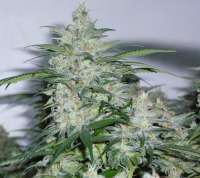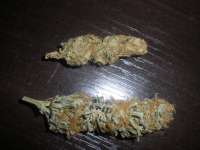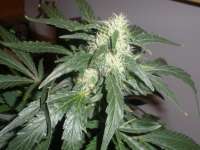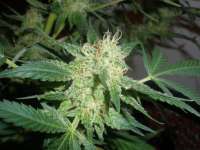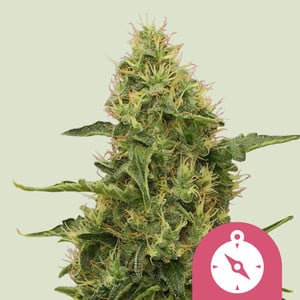Northern Lights
breed by Sensi SeedsHere you can find all info about Northern Lights from Sensi Seeds. If you are searching for information about Northern Lights from Sensi Seeds, check out our: Basic infos, Gallery, Medicinal Values, Degustation, Awards, Strain Reviews, Direct Comparisons, Lineage / Genealogy, Hybrids / Crossbreeds, User comments, Videos, for this cannabis variety here at this page and follow the links to get even more information. If you have any personal experiences with growing or consuming this cannabis variety, please use the upload links to add them to the database!
Basic infos
Northern Lights is an indica from Sensi Seeds and can be cultivated indoors (Where the plants will need a flowering time of ±48 days) Sensi Seeds's Northern Lights is/was never available as feminized seeds.
Sensi Seeds Description
Few cannabis strains can claim to have attained the fame of Northern Lights. A knockout descendant from ancient landrace strains, Northern Lights is known for its potency and great effects, as well as providing the genetic building blocks for countless other hybrids. Keep reading to learn all there is to know about Northern Lights cannabis, its origins, genetics, and more.
The History of Northern Lights
As is the case with many old-school cannabis classics, the origins and history behind Northern Lights is shrouded in mystery. Below, we'll recount a generally accepted version of how the strain came to be, but remember that a lot of this info is based on hearsay and legend.
The first Northern Lights cannabis plants were supposedly grown in the 1970s by a mysterious breeder known only as The Indian on an island near Seattle, Washington. Legend has it that The Indian grew a variety of Northern Lights plants, all of which had 100% Afghan genetics. According to cannabis folklore, these plants had dark-green colours, a robust and short stature, as well as a tight bud structure—something which wasn't so common at the time, when a lot of the weed in the US descended from the sativa plants being grown in Mexico, Colombia, and other nearby regions.
In 1985, the renowned breeder and seed entrepreneur Neville Schoenmakers apparently discovered Northern Lights while travelling in the US. Rumor has it that Neville brought live clones of different Northern Lights phenos back to The Netherlands, where he hybridized and stabilized the strain over the coming years. Neville is said to have eventually crossed the strain with a Thai landrace, creating a hybrid with a mix of sativa and indica genes but retaining many of the iconic traits of its Afghani ancestors. Out of the resulting seeds, Neville selected Northern Lights as the standout phenotype, though some sources suggest that Northern Lights #1 and #2 were also very good. Over the coming years, breeders used Northern Lights to create a plethora of iconic hybrids, including:
• Super Silver Haze
• Shiva Skunk
• Lowryder
• Jack Herer
• Neville's Haze
Genetic Lineage of Northern Lights
While its origin story is hazy at best, there's a general consensus regarding the genetic lineage of Northern Lights; the strain seems to be a direct descendant of both Afghani and Thai landrace cannabis varieties. Below we'll take a look at some of the unique characteristics of both Thai and Afghani landrace weed.
Note that the term Landrace refers to cannabis varieties that have grown naturally in a particular region for many generations without having been crossed with strains from other parts of the world. As a result of growing in a particular region for prolonged periods and being genetically isolated from other cannabis strains, landrace varieties develop particular traits as they adapt to their local environment.
Afghan weed (also known simply as Afghani), as its name suggests, refers to landrace strains growing in Afghanistan, particularly in rural and highland regions of the country, as well as near Mazar-I-Sharif (one of the country's largest cities). These varieties are typically pure indicas with tell-tale indica traits, including dark green foliage and broad-fingered leaves, a short, stocky stature, bushy growth, and a short flowering time. Afghani strains are also known to be resilient and produce dense flowers with a tendency to go purple when grown in the right conditions. Besides being used to create Northern Lights, Afghani genetics can also be found in strains such as Ak47, Amnesia Haze, Trainwreck, and many more.
Thai weed, on the other hand, refers to landrace plants originating from, you guessed it, Thailand. In contrast to Afghani landraces, Thai plants are typically sativas and have long adapted to Thailand's warm, humid conditions and long summers. Generally speaking, these are tall plants with long, reaching branches and stems, bright green foliage, thin-fingered leaves, and a long flowering time. These strains are renowned for their unique citric and fruit aromas, as well as their potent and uplifting effects. Like Afghani, Thai weed has been used by a plethora of breeders from all over the globe to produce a wide variety of hybrids, including Juicy Fruit, Haze, Oregon Purple Thai (AKA Purple Thai), and Blueberry, among many others.
Northern Lights is an indica-dominant variety with physical traits that are very reminiscent of its Afghani parent. However, the strain's effects couple the more relaxing effects of indica-dominant strains like Afghani with the uplifting mental effects typical of Thai landraces.
Physical Characteristics of Northern Lights
Northern Lights is known to have notable indica traits. In general, these plants are short and stocky, with moderate internodal spacing, and broad dark-green leaves. Once in bloom, the strain is said to stretch moderately and produce dense, pine-shaped flowers. In general, Northern Lights buds are a deep forest green riddled with bright yellow and orange pistils, as well as a thick coating of sticky resin. Like other old-school strains, Northern Lights tends to produce lighter flowers that lack the tight clusters of almost-bursting calyxes seen in modern cannabis hybrids. Nonetheless, Northern Lights buds smell great and make for a delicious smoke.
Properties/Effects of Northern Lights
Like a lot of old-school cannabis strains, Northern Lights typically isn't as loaded with THC as more modern cannabis varieties. Normally, this strain packs around 15–18% THC, though some batches may be a little stronger. Nonetheless, don't let those numbers fool you. Despite having less THC than more modern cannabis strains, Northern Lights is still known for producing a potent, long-lasting stone. Besides being very potent, Northern Lights also boasts a very classic aroma of fresh pine, with earthy undertones and spicy, herbal hints. According to some users, this strain is typically rich in myrcene, caryophyllene, pinene, and limonene.
Depending on your tolerance, Northern Lights can be nicely relaxing or completely immobilizing. In small doses or for users with a tolerance, this strain usually produces an enlightened and uplifted mental buzz, coupled nicely with a warm, relaxing body stone. In higher doses or for users who are more sensitive to THC and cannabis in general, Northern Lights can produce a heavy body stone that's perfect for getting a deep, restorative night's sleep.
Most users agree that this strain isn't really meant for the daytime or situations where you need to get things done. Instead, reserve Northern Lights for those moments when you want to completely unwind and relax without having to worry about staying productive or getting anything done. Light up this classic strain, kick up your feet, and let her entrancing stone wash away your worries and provide you with that downtime we all need and deserve.
Uses of Northern Lights
Ever since it was commercialized by Neville Schoenmakers and other Dutch breeders in the 1980s, Northern Lights has been winning over the hearts of pretty much anyone lucky enough to savour her sweet smoke. Recreational smokers, for example, treasure this strain:
• On weekends or public holidays
• While on vacation
• Out in nature (like when camping under a clear, starry sky)
• While watching movies or playing video games
• For relaxing after work or a workout
• Before bed
Medical cannabis users also treasure this strain, especially for its strong physical stone. According to reports from medical cannabis users, Northern Lights may help patients with:
• Depression
• Stress
• Anxiety
• Sleep disorders
• Chronic pain and inflammation
• ADD/ADHD
• Headaches
• OCD
• Muscle spasms
Northern Lights is a fairly well-tolerated strain. Unfortunately, it can cause side effects, like all cannabis can. According to reports from different users, both recreational smokers and MMJ patients, Northern Lights may cause the following negative side effects:
• Dizziness
• Dry mouth and eyes
• Paranoia
• Couchlock
Cultivation/Production of Northern Lights
As we mentioned earlier, Northern Lights is an indica-dominant strain with very clear indica traits. If you happen to sow Northern Lights seeds at home, expect to grow compact plants with moderately-spaced internodes and bushy, broad foliage. Northern Lights plants are known to be vigorous growers and resilient to pests, pathogens, as well as cold temperatures/unfavorable climates. Once in bloom, Northern Lights plants develop tight, small indica flowers typically shaped like pine trees. They tend to maintain their deep green color, though some varieties of Northern Lights may develop purple hues (depending on how they are grown).
Unlike a lot of old-school cannabis strains, Northern Lights has been fairly well-preserved, and a lot of seedbanks continue to offer this strain in seed form. Dutch seedbanks, in particular, are renowned for carrying good varieties of Northern Lights with the growth traits, aromas, and effects that characterize this famous variety. If you're looking to grow Northern Lights at home, consider checking out the following versions:
• Northern Lights by Zamnesia
• Northern Light by Royal Queen Seeds
• Northern Lights by Sensi Seeds
Northern Lights: A True Dutch Classic
From its humble beginnings on an island near Seattle, Washington, Northern Lights became a world-renowned cannabis classic after being discovered by Neville Schoenmakers and brought to Amsterdam. Today, decades after it first hit the market in the 1980s, Northern Lights continues to be a best-selling strain, favored by growers, recreational smokers, medical patients, and pretty much anyone lucky enough to light her up.
Northern Lights Awards
Northern Lights Reviews
Known Phenotypes
- long, stretched, slowly blossoming, sativa dominant, phenotype #1
More info
Please click here to see the full Plant-Profile!Indoor Strain Review
- Yield / Quantity
- The crop of this strain is very high
- Buds / Leaves
- The ratio of buds to leaves is above average
- Bud Structure
- The dried buds are hard and compact
- Strength / Lasting Effect
- The weed is very strong and long lasting
- Tolerance Built
- slightly below average tolerance education
Northern Lights Degustation
Effect/Effectiveness
Smell / Aroma
Taste
Northern Lights Medicinal Values
1 medical user(s) provided personal experiences about the medicinal values of Northern Lights from Sensi Seeds and specially it seem to help with Psychiatric Symptoms. Please find more information about the medical effects and the dosaging of Sensi Seeds' Northern Lights here at our detailed medical info page page for this variety.Northern Lights Gallery
Here you see the latest Northern Lights photos, uploaded from our users! Altogether we've collected 4 pictures from Sensi Seeds, check out our Northern Lights Gallery to view them all.Northern Lights Comparisons
How is Northern Lights growing and effecting compared to other varieties? 1 seedfinder users uploaded direct comparisons with Sensi Seeds' Northern Lights and compared this cannabis variety with 1 other strain(s). Click on the links to get more information and see how good this plants can be grown together!
Sensi Seeds Northern Lights: vs Shiva SkunkNorthern Lights Lineage / Genealogy
-
Northern Lights
»»»
NL #1
x
NL #2
x
NL #5
-
NL #1
(IBL)
- »»» Purest Indica x Afghani [probably from Neville]
-
Purest Indica
-
Afghani
- Afghanistan [Probably Indica] »»» Indica
-
Afghani
- Afghani [probably from Neville] (specified above)
- NL #2 (specified above)
-
NL #5
(#5)
- »»» Purest Indica x Hawaiian
- Purest Indica (specified above)
- Hawaiian »»» Sativa
-
NL #1
(IBL)
Northern Lights Hybrids & Crossbreeds
We found 73 direct descendants from Sensi Seeds in the seedfinder strain database, here a short overview. To see all hybrids and their descendants, visit our Northern Lights Genealogy Page and check out all the direct crosses as like as the following generations.
Northern Lights User comments
Altogether we've collected 9 about Sensi Seeds.Für eine Indika ist die Pflanze sehr potent und hat einen schönen ausgewogenen Turn. Nicht zu kopflastig und nicht zu plättend. Da beste ist aber das Aroma. Das ist das beste Aroma das ich seit langem hatte. Extrem fruchtig süß, mit einer Spur herber Würze. Intensiv. Einfach nur geil.
Mir persönlich ist die Wirkungsdauer solcher Indikas zu kurz. Ich mag nach wie vor eher Sativas, aber für einen Indikaliebhaber ist die NL von Sensi ein Muss. Die Pflanze ist vor allem schnell fertig. So um die acht Wochen. Super Pflanze für Anfänger oder wenns schnell gehen soll. Pflegeleicht. Bleibt klein und buschig.
Grows in short, strong bushes. Doesn’t need a lot of attention and is resistant to temperature changes. Hard buds with size a less bit than average and lots of resin. Very limited smell during flowering. Ideal for beginners.
Unique and characteristic smell after curing with a little bit more discreet taste ; melts spice and flowers with a noticeable skunky side.
Very short high period (20 to 30 minutes), very progressive and anesthetic, followed by an intense stone effect for at least one hour more. Very strong, physical and quick-ass medication.
A must-have for every Afghani strain lover !
There are 7 more comments in the following locales: de (6) en (2) es (1)
Northern Lights Videos
Here you find connected videos about Northern Lights. Please click to the preview-image to play the video directly here in the page (data will be loaded from the external video page) - or click to the title of the video to open the video page in a new window.
![[Lost Footage] Northern Lights Strain History featuring CSI Humboldt S02 E11 Making Cannabis History thumbnail](https://cdn.seedfinder.eu/pics/video/youtube/m7nozyIyy0k.jpg)
[Lost Footage] Northern Lights Strain History featuring CSI Humboldt S02 E11 Making Cannabis History
Another one from the IG archives, before we started recording on YouTube. The audio version of this...
13-07-2023 01:24Upload your info about this strain here:
Do you know something more about Sensi Seeds? Please help to make this database better and upload/connect your information here!
Pictures
Pictures speak louder than words! Upload your "Northern Lights" Photos here and help other growers to get a better impression of this variety.Comparisons
Northern Lights VS. Strain direct comparisation formUser Reviews
Our strain reviews are multilingual, searchable and can be very detailed - including data about the grow, aroma, effects and taste! Please upload your Northern Lights Review here to help the other seedfinder users!
Medical Values
You have experience with the medical qualities of Northern Lights? Sharing your information here maybe can help other people!
Threads
You've stumbled upon a Northern Lights related thread into a forum or growers community? Connect it here and enable othe users to find this information fast and easy!
Videos
You found a related video with additional information or grow-infos about Northern Lights on YouTube? Please connect it here to the strain info page!
